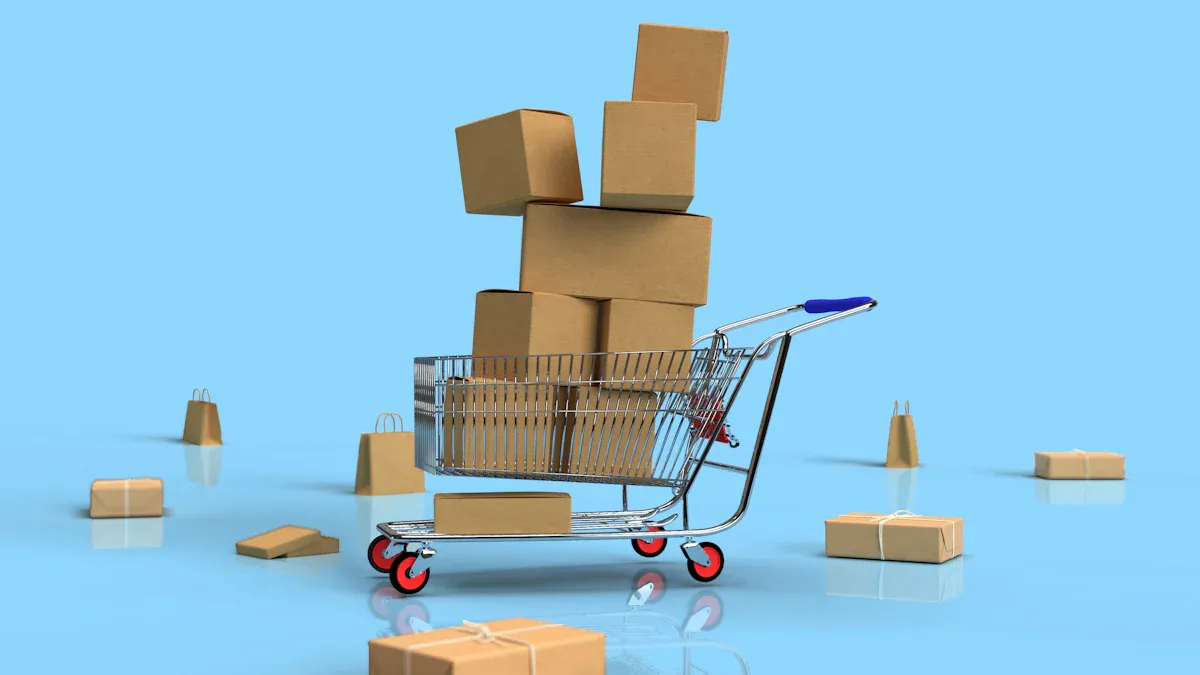Strategies to Tackle Q4 Logistics Bottlenecks and Boost Customer Satisfaction

Every year, Q4 has lots of orders and big hopes. Companies deal with Q4 Logistics Bottlenecks that slow deliveries. This can make customers upset. Surveys say carrier problems cause most delivery troubles. On-time rates go down when e-commerce goes up. Customers want fast and reliable service. Longer transit times and random deliveries make people less happy. Quick action and smart planning help teams fix these problems. This keeps customers happy, even in busy months.
Key Takeaways
Q4 logistics bottlenecks happen when systems are slow, there are not enough workers, and space is tight. This causes delays and makes customers unhappy. Accurate demand forecasting uses old data and AI tools. This helps companies get ready with enough stock. It also helps them not run out during busy times. Regular inventory audits and smart replenishment keep shelves full. They also help lower mistakes and make order fulfillment faster. Freight capacity is tight in Q4. Working with good carriers and using flexible contracts helps get deliveries on time. Fast and accurate order fulfillment uses barcode scanning and real-time tracking. This makes customers trust the company more and feel happy. Automation makes picking and packing faster. It lowers labor costs and helps handle many orders well. Watching key performance indicators (KPIs) helps teams find problems early. It also helps them make delivery and service better. Good communication and risk planning with suppliers build strong partnerships. This stops delays and keeps things running smoothly.
Q4 Logistics Bottlenecks
Common Causes
Process and System Limitations
Many companies have trouble in Q4 because their systems are too slow. Old software makes it hard to process orders fast. Trucks get stuck waiting at docks and yards. This happens when there are too many trucks and not enough space. Some companies use the same contracts all year. This makes it hard to handle more orders during busy times. It is tough to hire new workers quickly before Q4 starts. High labor costs make it hard to change staff numbers. When people work too much, they get tired and make mistakes.
Tip: If companies upgrade their warehouse management systems and use flexible contracts, they can react faster in Q4.
Here is a table that lists the most common Q4 Logistics Bottlenecks:
Bottleneck Type | Description |
|---|---|
Last-minute labor shortages | It is hard to find good seasonal workers late in the season. This causes problems with cost and efficiency. |
Dock and yard congestion | Bad dock scheduling stops trucks from moving fast. This slows down work. |
Over-reliance on fixed contracts | Contracts do not help with sudden demand. This makes partners upset and causes missed agreements. |
Slow hiring cycles | It takes a long time to hire and train new workers. This means teams are not ready for busy times. |
High fixed labor costs | Companies pay salaries and fees even when they do not need as many workers. |
Overtime and employee burnout | Too much overtime makes workers tired. They make more mistakes and leave their jobs. |
Fulfillment delays | Not enough workers or space slows down order processing. Deliveries are late. |
Tight warehousing and freight capacity | There is not enough space or trucks, especially in busy places and cold storage. |
Cross-border logistics complexity | Tariffs and trade rules make shipping harder. Holiday bans also cause problems. |
Contract and compliance challenges | Contract terms, labor rules, and cyber risks are bigger problems in Q4. |
Human Error and Resource Constraints
People make more mistakes when they are tired or rushed. Q4 is busy, so workers have long hours and lots of stress. Overtime and burnout cause errors in picking, packing, and shipping. Not enough workers means more work for everyone. Slow hiring means teams are not ready for busy times. High labor costs make it hard to add or remove workers. Fulfillment delays happen when there are not enough people or space.
Labor shortages and problems with temporary workers slow down work. Companies must also follow rules about insurance and safety.
Overtime makes workers tired. This leads to mistakes and people quitting.
Contract rules like late delivery grace periods and extra charges make things more complicated.
Cybersecurity risks are higher for transportation and warehouse systems in Q4.
External Factors
Seasonal Demand
Q4 is the busiest time for stores and online shopping. Sales and special events make orders go up fast. Q3 and Q4 can be almost half of all yearly sales. Companies need more space and workers, but many people take time off. Suppliers also run out of products. These problems make it hard to make and ship orders on time. Shipping and storage costs go up because carriers charge more for fuel, labor, and busy times.
Big spikes in demand mean companies need more space and face more delays.
Not enough seasonal workers makes it hard to run warehouses, drive trucks, and help customers.
These problems slow down making products, shipping orders, and reacting to changes.
Weather and Market Dynamics
Weather can cause many Q4 Logistics Bottlenecks. Storms or droughts delay shipments and stop ships from moving. Problems like the Red Sea Crisis make ships take longer routes. This raises costs and adds time. Trade fights between the US and China mean higher tariffs and less steady imports. Broken bridges or roads block important routes. Holidays like China’s Golden Week stop factories and cause shipping delays.
Fights between countries change shipping routes and raise costs.
Bad weather and broken roads delay shipments and make logistics harder.
Uncertain economies and rising prices make planning more difficult.
Note: If companies prepare early, forecast well, and work with trusted logistics partners, they can handle these outside risks better.
Impact on Supply Chain Efficiency and Customer Satisfaction
Q4 Logistics Bottlenecks slow down the supply chain and make customers unhappy. Factories get busy, so it takes longer to make things. Shipping gets crowded, so deliveries are late. Shipping costs go up, so profits go down. Delays make customers upset and lead to refunds or chargebacks. Bad planning can make companies run out of products too soon and miss chances to sell more. Bottlenecks cause delays, higher costs, and unhappy customers. Not enough suppliers and bad logistics make things worse.
Technology like AI-powered analytics helps spot and stop bottlenecks fast.
Good supplier relationships and having more options make companies more flexible.
Always looking for ways to improve and using agile plans keeps supply chains working well.
Regular checks, teamwork, training, crisis plans, and watching KPIs help find and fix problems.
Q4 Logistics Bottlenecks affect every part of the supply chain. Companies that plan ahead and use smart ideas can keep customers happy and make sure deliveries arrive on time.

Demand Forecasting
Data and Trends
Q4 means lots of orders come in fast. It is hard to know how much stock to buy. Companies use many kinds of data to help them decide. They look at last year’s sales, what is selling now, and how much stock they have. They also listen to suppliers and experts about sales and demand changes. Teams mix numbers with advice to find patterns and avoid problems.
Looking at old Q4 sales helps companies see what worked and what did not.
Teams check order numbers, stockouts, shipping delays, and feedback from past busy seasons.
Real-time inventory tracking with 3PL systems keeps stock counts right and helps set reorder points.
People are spending more carefully now. Even though paychecks are bigger, many have high bills and loans. Prices are going up too. The University of Michigan’s Consumer Sentiment Index dropped in October 2023. This shows people worry about money. Companies may sell more basic goods and less extras. This makes forecasting even more important.
Tip: If companies plan holiday stock by late summer or early fall, they can avoid running out and shipping problems.
Predictive Tools
Forecasting tools are much better now. Companies use AI-powered software, moving averages, and regression analysis to guess demand. These tools look at numbers and outside things like weather or news. Machine learning can find patterns people miss.
Here are some common forecasting methods:
Method | Best For | How It Works |
|---|---|---|
Quantitative | Steady growth or clear patterns | Uses past sales data and trends |
Qualitative | New products or little data | Uses surveys and expert opinions |
Combined Approach | Volatile or changing markets | Mixes numbers with real-world info |
AI and predictive analytics can cut mistakes in forecasts by half. They also help lower storage costs and keep the right amount of stock. Companies use real-time sales data from stores and online to change forecasts fast. This helps them react to sudden changes in demand.
Stakeholder Collaboration
No one can guess Q4 demand alone. Teams work with suppliers, carriers, and stores to share info and plan together. Talking early and clearly with suppliers helps them get ready for big orders. This stops delays and keeps shelves full.
Planning software lets everyone see the same numbers and updates right away.
Advanced ERP systems link buying, stock, and sales data. This helps spot problems early.
Sharing calendars and market trends helps everyone know what is happening.
When companies, suppliers, and carriers work together, they can handle surprises faster. This teamwork means better forecasts, fewer empty shelves, and happier customers.
Inventory Management
Audits and Accuracy
Inventory audits are very important in Q4. Companies often find lost items and wrong shipments. Messy shelves and missed returns also cause mistakes. These problems make it hard to fill orders fast. Keeping good records and neat warehouses helps teams make fewer mistakes. Red Stag Fulfillment has a Q4 error rate of just 0.024%. This means they get almost every order right. Most companies have error rates from 1% to 3%. Fewer mistakes mean faster shipping and happier customers. Teams that focus on being correct spend less time fixing errors and get fewer returns.
Tip: Checking inventory often and keeping clear records helps teams find problems early and ship orders quickly.
Replenishment Planning
Replenishment planning keeps shelves full in Q4. Teams use smart ways to stop stock from running out. They use real data and tools, not just guesses. Here are some good ideas for Q4 replenishment:
Check demand forecasts often. Teams compare guesses with real sales and change plans fast.
Work together with other departments. AI tools help everyone see the same numbers and make fewer mistakes.
Watch inventory in real time. Spreadsheets can miss changes, but live tracking shows what is happening now.
Talk to suppliers about reorder prices. Good planning helps teams get better deals and flexible orders.
Bahadir Efeoglu, CEO of Fabrikatör, says good forecasting and real-time tracking are important. He suggests using inventory tools that work with Shopify. These tools help brands get ready for busy days like Black Friday. Automated forecasting and synced data keep inventory at the right level. This helps companies avoid running out or buying too much.
Note: Teams that use technology and share info can react faster and keep customers happy.
Safety Stock
Safety stock is extra inventory for busy Q4 times. Companies set safety stock by looking at demand changes and supplier reliability. They use formulas that include demand swings and delivery times. For popular products, teams want service levels of 98% to 99%. They do not count odd sales days to make forecasts better. Advanced methods like Monte Carlo simulations help decide how much extra stock to keep.
Here is a table showing what matters most for Q4 safety stock:
Factor / Method | Role in Q4 Peak Season Optimization |
|---|---|
Demand Variability | Teams look at past sales spikes and adjust safety stock for busy times. |
Lead Time and Lead Time Variability | Longer or unpredictable delivery times mean more safety stock is needed. |
Supplier Reliability | Reliable suppliers let teams keep less extra stock. |
Product Perishability | Perishable goods need careful planning to avoid waste. |
Desired Service Levels | High-demand items get higher service levels to avoid running out. |
Advanced Statistical Models | Simulations and data models help set the right safety stock for complex patterns. |
Technology and Dynamic Recalculation | Modern systems adjust safety stock in real time as demand and supply change. |
Product Segmentation | Teams group products by demand type and set safety stock for each group. |
Companies that use these methods keep shelves full and avoid big mistakes. Smart safety stock planning means fewer lost sales and happier customers in Q4.
Freight Capacity
Market Challenges
Freight capacity is a big worry in Q4. Companies get more orders, but trucks and drivers can’t always keep up. Many things make this problem worse:
Factories make fewer goods, so less goes by truck. This drop is between 0.3% and 0.9% each year. Truck freight feels this the most.
There are too many trucks and not enough loads. This keeps freight rates low. Carriers have trouble making money.
Winter changes things. Dry van truckload capacity gets easier to find. Spot market rates often go down. Outbound tender rejection rates also drop, but they are still higher than last year.
Ports on the East and Gulf Coasts get crowded. This slows shipments. Geopolitical problems and new trade rules cause more delays.
Many carriers left earlier in the year. Q4 saw a few new carriers, but there are still too many trucks.
Weather is also a big factor. Bad storms and cold weather make it harder to find trucks in some places. The East Coast often has storms and busy ports, so capacity is tight. South Texas gets busy with produce season and bad weather. This makes it the hardest place to find trucks. In the Pacific Northwest, storms can cause sudden delays. In cold states like Colorado and North Dakota, winter weather makes flatbed capacity low. Drivers do not want to drive on risky roads.
Note: When storms come, more people need trucks. This makes rates go up and space harder to find.
Partnering with Providers
Working with good freight providers helps in Q4. Talking clearly is the first step. Companies share shipping cutoff dates early. They match these dates with carrier deadlines. This helps everyone know the plan.
Being flexible is important. Companies compare rates and keep backup carriers ready. They use extra workers and spread warehouses across the country. Same-day fulfillment helps with sudden order spikes. Box optimization and rate shopping tools help save money.
Many teams use third-party logistics (3PL) providers. These partners get better carrier rates and help avoid extra fees. Real-time tracking and inventory visibility keep customers happy. Teams can spot problems fast.
Tip: Good relationships with carriers all year help companies get the best loads in Q4. Signing contract rates before peak season helps control costs.
Capacity Planning Tools
Smart planning tools help a lot in Q4. Teams look at old freight data first. They find busy times and plan maintenance for slow periods. Scenario modeling tools let them test plans 30 to 60 days before peak season.
Companies mix their own trucks with rentals. They move trailers based on real data. This helps use every truck well. Some teams use fewer long leases and more rentals in busy months. This keeps costs low and lets them react fast.
Modern freight management technology helps too. Load tracking, digital paperwork, and real-time updates keep everyone informed. Route optimization and fuel card programs save money and time. Factoring services help companies get paid faster. This helps them grow when needed.
Tool/Strategy | Benefit in Q4 Peak Season |
|---|---|
Scenario Modeling | Tests plans before busy times |
Real-Time Tracking | Helps see shipments and serve customers |
Flexible Rentals | Adds trucks without long-term costs |
Route Optimization | Saves money and speeds up deliveries |
Factoring Services | Keeps cash flow steady |
Companies that use these tools and work well with partners do better in Q4. They deliver on time and keep customers happy.
Order Fulfillment

Accuracy and Speed
Order fulfillment is harder in Q4. Companies get more orders and less time. Teams need to pick, pack, and ship fast. Mistakes make customers upset and cause returns. Good training helps workers do their jobs well. Workers learn to find errors and fix them before shipping. Many companies use barcode scanners and automated picking systems. These tools help workers find items and pack them quickly.
A simple checklist helps teams avoid mistakes:
Check order details before packing.
Use barcode scanners for each item.
Teach workers to spot damaged goods.
Pack orders carefully to stop breakage.
Check shipping labels to make sure they are right.
Speed is important, but accuracy matters more. When teams get orders right, they save time and money. Customers are happy when packages arrive fast and in good shape.
Tracking and Visibility
Customers want to know where their orders are. Real-time tracking makes this easy. Companies use tracking tools to send updates from the warehouse to the customer. These updates help customers trust the company.
Customers want clear updates during busy times.
Automated tracking means fewer questions about shipments.
Being open helps customers trust the brand.
Analytics help set delivery times and choose which orders to ship first.
Real-time tracking helps companies find problems early. If a shipment is late, teams can act fast and tell customers. This stops bad reviews and keeps customers happy.
Teams can talk quickly if something goes wrong.
Dynamic inventory tracking lets companies move stock to meet demand.
Operations change from fixing problems to stopping them before they happen.
Connecting with online stores lets customers track packages easily. This lowers service calls and makes customers happier. Customers feel in control and less worried during Q4.
Packaging and Personalization
Packaging protects products and makes a good first impression. Custom packaging makes opening packages fun. Customers who like unboxing are more likely to buy again. Studies show a good unboxing experience brings back 60% of buyers.
Companies use strong materials, eco-friendly designs, and stories on boxes. QR codes link to brand stories or care guides. These touches make customers feel special.
Eco-friendly packaging with QR codes helps repeat purchases and sharing.
Personalized notes and strong packaging lower returns and get more referrals.
Assembly guides and care booklets mean fewer customer service calls.
Fabric samples and holiday packaging help follow-up sales and emotional bonds.
Holiday packaging with fun designs makes customers happy. Special boxes and booklets create memories. These ideas lower returns and build loyalty, especially in Q4. Customers share their experiences online and help brands get new buyers.
Tip: Companies that spend on packaging and personalization get fewer returns and more loyal customers. A great unboxing experience turns new buyers into fans.

Technology Solutions
Real-Time Tracking
Real-time tracking changes how companies deliver in Q4. GPS and smart software show where trucks and packages are right now. This live info helps companies tell customers when their orders will arrive. When customers know the delivery time, they feel calm and sure.
GPS and API tools show where things are and when they will arrive. This helps stop missed deliveries.
Flexible delivery times and good route plans help drivers reach people at home. This means fewer failed deliveries.
Amazon’s map tracking let customers see their driver. Failed deliveries dropped by 7%.
Updates by text, email, or app keep customers informed. This makes people happier and lowers missed deliveries.
A report said 70% of online shoppers like real-time tracking. It makes them want to order again.
J&M Contracting uses GPS tracking to stop theft and keep projects on time. They find lost equipment fast and avoid delays. Delivery companies use these ideas to stop late shipments and keep customers happy. Some brands improved on-time deliveries by 23% with micro-stations and tracking. Others saved money and handled 40% more orders in Q4 by using tracking and smart messages.
Tip: Real-time tracking helps teams find problems early and fix them before customers notice.
Automation
Automation makes Q4 logistics faster and more reliable. Robots and smart machines help workers pick, pack, and ship orders quickly. This means fewer mistakes and faster deliveries.
Robots can make picking 70% faster. Orders get packed and shipped quickly.
Automated warehouses use less space and earn more money.
Labor shortages happen a lot in Q4. Automation helps companies do more with fewer workers.
Labor costs are a big part of logistics. Automation cuts these costs and helps workers do more.
Big companies like FedEx and Amazon use automation to handle busy times and higher wages.
Automated storage, sorting, and conveyor systems speed up every step from receiving to shipping. Micro-fulfillment centers near cities help companies deliver faster and save money. Some brands saw delivery times drop by 20% and driver productivity go up by 15% after using automation. Companies also report 99.9% picking accuracy and 30% lower labor costs. Training and smart software help teams use these new tools well.
KPI Monitoring
Key performance indicators, or KPIs, help companies track how well their Q4 logistics work. These numbers show what is working and what needs fixing.
On-time delivery rate shows how many orders arrive on time.
Delivery success rate tracks orders delivered without problems.
Cost per delivery helps companies see if they spend too much.
Customer satisfaction scores come from feedback and reviews.
Failed delivery rate shows where things go wrong.
Delivery density measures how many stops drivers make in one area.
Average time per stop shows how fast drivers finish each delivery.
Package condition on arrival checks for damage.
Other important KPIs are average dwell time at docks, transportation costs, and customer claims. Companies also watch return rates and how much they pay each carrier. By checking these numbers often, teams can spot trends, fix problems, and keep customers happy during the busiest time of year.
Note: Watching KPIs closely helps companies find problems early and give great service in Q4.

Supplier Partnerships
Communication
Good supplier partnerships begin with clear talking. Companies talk to suppliers often to find problems early. They use check-ins, emails, and shared dashboards to stay updated. Teams share real-time news about inventory and shipments. This helps them react fast when things change.
Companies check suppliers before making deals. They look at cybersecurity, compliance, and money strength.
Teams set clear SLAs and KPIs so everyone knows the rules.
Reviews and audits help track how suppliers are doing.
Open channels let teams spot problems fast and fix them together.
Shared platforms help everyone see updates and data.
Tip: If companies write down who to call during problems, they fix issues faster and keep things moving.
Risk Management
Q4 has more risks, so companies need strong risk plans. They find which suppliers have the biggest risks, like weather or politics. Teams do not use just one supplier. They build a group of partners to stay flexible.
Companies make backup plans for every step, so work does not stop if something fails.
They check suppliers for risks from location, politics, and the economy.
Teams use many suppliers so they do not get stuck if one fails.
Crisis teams and clear talking help everyone act fast in emergencies.
Training helps everyone watch for risks.
Technology gives real-time news on supplier risks, so teams can act early.
Data science helps teams see what could go wrong and get ready.
Companies keep all risk data in one place for easy use.
They use the PPRR model: Prevention, Preparedness, Response, and Recovery.
Extra inventory and nearshore suppliers help stop delays.
Teams test their supply chain to find weak spots.
Cybersecurity checks keep data and shipments safe.
Companies that train workers, talk openly, and use smart tools build a strong risk-aware team.
Contingency Planning
Q4 needs special backup plans because demand can jump a lot. Companies make Plans A, B, and C for surprises like driver shortages or bad weather. They work with 3PLs for extra trucks, warehouses, and emergency help.
Teams focus on being flexible and able to grow. They keep extra stock and plan new shipping routes.
Testing plans helps find weak spots before they cause trouble.
Same-day delivery, backup drivers, and 24/7 help are very important in Q4.
Companies start planning for next Q4 right after this one ends. They use what they learned to get better.
A clothing store once had a winter storm block main roads. They quickly used backup warehouses and kept orders moving. Fast action like this keeps customers happy, even when things go wrong.
Note: Q4 backup plans are more detailed and urgent than other times. Companies that plan well avoid slowdowns and deliver on time, no matter what happens.
Planning ahead helps teams stop Q4 Logistics Bottlenecks early. Companies look at old data and use smart tools to find risks fast. They match logistics plans with business goals and use automation for better results. Easy product bundling, early holiday planning, and flexible labor help customers feel happy. Teams that check their logistics and meet to plan get faster service and happier customers. Always improving keeps operations strong every Q4.
FAQ
What is a Q4 logistics bottleneck?
A Q4 logistics bottleneck is when too many orders come in at once. This slows down the supply chain. Deliveries can be late, and customers may get upset. These problems happen more during the busy holiday season.
How can companies avoid running out of stock in Q4?
Teams use demand forecasting and safety stock to help. They look at sales numbers and talk with suppliers. Smart tools help them plan early and keep shelves full.
Why does weather affect Q4 deliveries?
Bad weather, like snow or storms, can block roads. Trucks get delayed, and ships may need new routes. These things slow deliveries and make costs go up.
What technology helps with Q4 logistics?
Companies use real-time tracking, automation, and inventory software. These tools show where orders are and help pick items faster. They also help fix problems before customers notice.
How do companies keep customers happy during delays?
They send updates and answer questions quickly. Companies offer refunds or discounts if needed. Good communication helps customers trust the company and want to buy again.
What is the best way to handle sudden spikes in orders?
Teams get ready by training workers and using backup carriers. They keep extra stock and make flexible plans. Quick action helps when lots of orders come in.
How do companies choose the right freight partners?
Criteria | Why It Matters |
|---|---|
Reliability | Delivers on time |
Flexibility | Handles busy times |
Good rates | Saves money |
Communication | Fixes problems faster |

TangBuy: A Smarter Way to Dropship in 2025
If you're looking to stay competitive with dropshipping in 2025, speed and trend-awareness are key. TangBuy helps you stay ahead with real-time product trends, fast fulfilment, and factory-direct sourcing. With over 1 million ready-to-ship items, 24-hour order processing, and seamless Shopify integration, TangBuy makes it easier to test, scale, and succeed in today's fast-moving eCommerce landscape.
See Also
Effective Ways To Attract More Buyers To Your Store
Common Supplier Communication Errors And Tips To Prevent Them
How Bento Boxes Enable Dropshippers To Thrive With Low Risk

